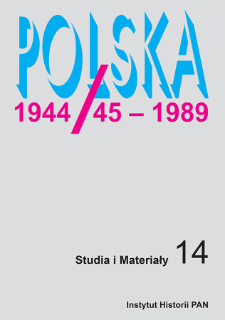
Object
Title: „Pyły, ludzie, przyroda” : zanieczyszczenie powietrza atmosferycznego w województwie kieleckim w latach 1975–1989
Subtitle:
Polska 1944/45-1989 : studia i materiały 14 (2016)
Contributor:
Institute of History of the Polish Academy of Sciences
Publisher:
Institute of History of the Polish Academy of Sciences
Place of publishing:
Description:
p. 189-203 : ill. ; Abstract eng.
Type of object:
Abstract:
The industrialization of the 1975–1989 period brought changes in spatial development and transformations in the human natural environment. New industrial investments required space for their implementation. As a result, the size of green areas near the cities gradually decreased. In addition, the activity of the “old” plants, as well as those under development, posed a serious threat to the environment. These problems were also evident in the province of Kielce. In the middle of the Gierek’s decade the region ranked fifth in the country in terms of the amount of pollution emitted into the atmosphere. In the area of “White Basin”, where many cement and lime factories were concentrated, dust fallout production standards were exceeded even several times. Results of the analyses on the problem of environmental threats may become an important part of the debate on socio-economic processes taking place in Poland during the postwar period. Hitherto studies of industrialization in the years 1944/1945–1989 focused mainly on its social consequences. However, they almost completely ignore the issue of degradation of the ecosystem, which is also closely associated with the industrialization pursued.
References:
Domańska E., Wiedza o przeszłości – perspektywy na przyszłość, „Kwartalnik Historyczny” 2013, nr 2
Dulewicz J., Inwestycje przemysłowe a proces urbanizacji małych i średnich miast oraz ich wpływ na stan środowiska naturalnego w województwie kieleckim w latach 1971–1975, „Między Wisłą a Pilicą. Studia i Materiały Historyczne” 14 (2013)
Dulewicz J., Zawisza M., Społeczeństwo polskie wobec katastrofy w elektrowni w Czarnobylu, w: Od powietrza, głodu, ognia i wojny… Klęski elementarne na przestrzeni wieków, red. T. Głowiński, E. Kościk, Wrocław 2013
Dulewicz J., Katastrofa w Czarnobylu i jej wpływ na sytuację w Polsce, w: Zimowa Szkoła Historii Najnowszej 2014. Referaty, red. M. Hańderek, Ł. Kamiński, Warszawa 2015
Foltz R.C., Czy przyroda jest sprawcza w znaczeniu historycznym? Historia świata, historia środowiska, oraz to, w jaki sposób historycy mogą pomóc ocalić Ziemię, w: Teoria wiedzy o przeszłości na tle współczesnej humanistyki, red. E. Domańska, Poznań 2010
Jastrzębski S., Kierunki ochrony środowiska przyrodniczego w Polsce, „Rocznik Nauk Rolniczych” 1976, Seria D – Monografie, t. 158
Sadowska J., Czarnobyl – oblicza pamięci o wielkim strachu, „Biuletyn Historii Pogranicza” 11 (2011)
Szpak E., Kultura czy natura? Historia środowiskowa jako przedmiot badań historycznych, „Alma Mater. Miesięcznik Uniwersytetu Jagiellońskiego” 155 (2013)
Tracz B., Z problemów życia codziennego mieszkańców Rybnika w latach osiemdziesiątych XX w., w: Studia z dziejów ziemi rybnicko-wodzisławskiej, red. A. Dziurok, B. Kloch, Rybnik 2011
Relation:
Polska 1944/45-1989 : studia i materiały
Volume:
Start page:
End page:
Detailed Resource Type:
Format:
Resource Identifier:
oai:rcin.org.pl:61449 ; 2450-8357
Source:
IH PAN, sygn. B.155/14 Podr. ; IH PAN, sygn. B.156/14 ; click here to follow the link
Language:
Language of abstract:
Rights:
Creative Commons Attribution BY-ND 4.0 license
Terms of use:
Copyright-protected material. [CC BY-ND 4.0] May be used within the scope specified in Creative Commons Attribution BY-ND 4.0 license, full text available at: ; -
Digitizing institution:
Institute of History of the Polish Academy of Sciences
Original in:
Library of the Institute of History PAS
Access:
Object collections:
- Institute of History PAS > Serials
- Institute of History PAS > Institute Publications
- Institute of History PAS > Institute Publications > Journals
- Institute of History PAS > Institute Publications > Journals > Polska 1944/45-1989
Last modified:
Oct 2, 2020
In our library since:
Jan 5, 2017
Number of object content downloads / hits:
1647
All available object's versions:
https://rcin.org.pl/ihpan/publication/80714
Show description in RDF format:
Show description in RDFa format:
Show description in OAI-PMH format:
Objects Similar
Jarosz, Dariusz (1959– )
Jarosz, Dariusz (1959– )
Kuta, Cecylia
Jarosz, Dariusz (1959– )
Miernik, Grzegorz (1960– )
Rusin, Michał
Sanojca, Karol

 INSTYTUT ARCHEOLOGII I ETNOLOGII POLSKIEJ AKADEMII NAUK
INSTYTUT ARCHEOLOGII I ETNOLOGII POLSKIEJ AKADEMII NAUK
 INSTYTUT BADAŃ LITERACKICH POLSKIEJ AKADEMII NAUK
INSTYTUT BADAŃ LITERACKICH POLSKIEJ AKADEMII NAUK
 INSTYTUT BADAWCZY LEŚNICTWA
INSTYTUT BADAWCZY LEŚNICTWA
 INSTYTUT BIOLOGII DOŚWIADCZALNEJ IM. MARCELEGO NENCKIEGO POLSKIEJ AKADEMII NAUK
INSTYTUT BIOLOGII DOŚWIADCZALNEJ IM. MARCELEGO NENCKIEGO POLSKIEJ AKADEMII NAUK
 INSTYTUT BIOLOGII SSAKÓW POLSKIEJ AKADEMII NAUK
INSTYTUT BIOLOGII SSAKÓW POLSKIEJ AKADEMII NAUK
 INSTYTUT CHEMII FIZYCZNEJ PAN
INSTYTUT CHEMII FIZYCZNEJ PAN
 INSTYTUT CHEMII ORGANICZNEJ PAN
INSTYTUT CHEMII ORGANICZNEJ PAN
 INSTYTUT FILOZOFII I SOCJOLOGII PAN
INSTYTUT FILOZOFII I SOCJOLOGII PAN
 INSTYTUT GEOGRAFII I PRZESTRZENNEGO ZAGOSPODAROWANIA PAN
INSTYTUT GEOGRAFII I PRZESTRZENNEGO ZAGOSPODAROWANIA PAN
 INSTYTUT HISTORII im. TADEUSZA MANTEUFFLA POLSKIEJ AKADEMII NAUK
INSTYTUT HISTORII im. TADEUSZA MANTEUFFLA POLSKIEJ AKADEMII NAUK
 INSTYTUT JĘZYKA POLSKIEGO POLSKIEJ AKADEMII NAUK
INSTYTUT JĘZYKA POLSKIEGO POLSKIEJ AKADEMII NAUK
 INSTYTUT MATEMATYCZNY PAN
INSTYTUT MATEMATYCZNY PAN
 INSTYTUT MEDYCYNY DOŚWIADCZALNEJ I KLINICZNEJ IM.MIROSŁAWA MOSSAKOWSKIEGO POLSKIEJ AKADEMII NAUK
INSTYTUT MEDYCYNY DOŚWIADCZALNEJ I KLINICZNEJ IM.MIROSŁAWA MOSSAKOWSKIEGO POLSKIEJ AKADEMII NAUK
 INSTYTUT PODSTAWOWYCH PROBLEMÓW TECHNIKI PAN
INSTYTUT PODSTAWOWYCH PROBLEMÓW TECHNIKI PAN
 INSTYTUT SLAWISTYKI PAN
INSTYTUT SLAWISTYKI PAN
 SIEĆ BADAWCZA ŁUKASIEWICZ - INSTYTUT TECHNOLOGII MATERIAŁÓW ELEKTRONICZNYCH
SIEĆ BADAWCZA ŁUKASIEWICZ - INSTYTUT TECHNOLOGII MATERIAŁÓW ELEKTRONICZNYCH
 MUZEUM I INSTYTUT ZOOLOGII POLSKIEJ AKADEMII NAUK
MUZEUM I INSTYTUT ZOOLOGII POLSKIEJ AKADEMII NAUK
 INSTYTUT BADAŃ SYSTEMOWYCH PAN
INSTYTUT BADAŃ SYSTEMOWYCH PAN
 INSTYTUT BOTANIKI IM. WŁADYSŁAWA SZAFERA POLSKIEJ AKADEMII NAUK
INSTYTUT BOTANIKI IM. WŁADYSŁAWA SZAFERA POLSKIEJ AKADEMII NAUK
































